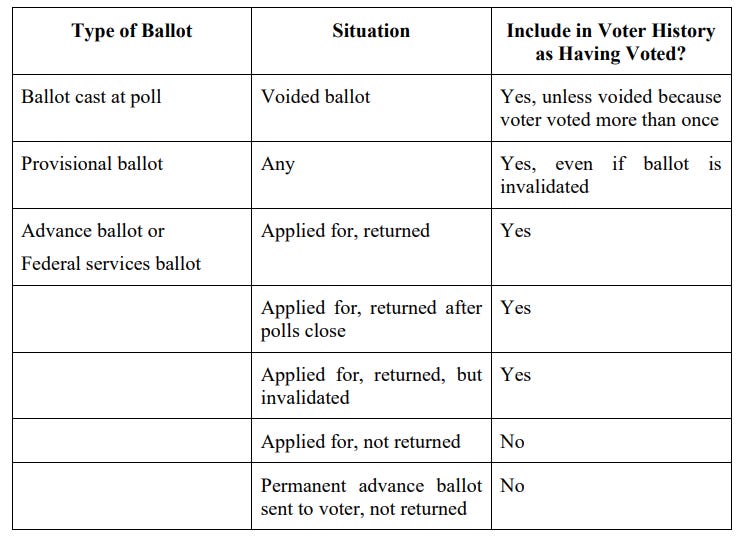Does Kansas have nearly 320,000 registered voters "eligible" to be delisted?
Did the federal Help America Vote Act Act envision such bloated voter rolls?
This is the second in a series of articles about Kansas voter registration data analysis.
A state law from 2022 gave Kansas election officials a new way to mark voters as “inactive,” which starts the waiting period for a voter to be removed from the voter roll.
But that waiting period can be three or more years until after the voter misses two more federal elections.
Unfortunately, Kansas election officials do not appear to be taking advantage of this new law as part of voter list maintenance. Why?
Census numbers hint at the ever-growing bloat
While the Kansas census population grew 117,488 (4.1% ) from 2010 (2,853,118) to July 2024 (2,970,606), the Kansas voter file grew 282,878 (16.5%) from Sept. 7, 2010 (1,712,701) to Sept. 6, 2024 (1,995,579).
Why is the voter list growing at a faster rate than the population?

Newly registered voters are being added to the voter rolls, but older voters (especially, 65+) are staying on the list for many years, which is indicated in the comparison to census populations in the chart above.
May 2025 voter file
A voter file from May 2nd from the Secretary of State’s office has over 2 million Kansas registered voters.
The diagram below shows two ways registered voters stay on the voter list but not vote. Some people register and never vote. Others register and vote for a few years, but then stop voting for a variety of reasons.

Of the 138,864 registered voters who have never voted, 110,333 (~80%) are still marked “active” even though new state law allows election officials to mark all of them “inactive” and start the removal process. Why isn’t this happening?
Of the 255,219 voters who cast ballots in 2020 or earlier but not since then, 206,842 (~81%) are still marked “active” even though new state law enables election officials to mark all of them “inactive” and start the removal process. Why isn’t this happening?
So, in round numbers, 80% of the nearly 400,000 registered voters not participating in any election activity in the last four years should have been marked “inactive” by the 105 Kansas county election officials.
This would add another 320,000 inactive voters, making them eligible for removal after missing the 2026 and the 2028 federal elections. Kansas only has 118,097 inactive voters in the May 2nd file.
The removal process is painfully, glacially slow, but does not work at all when election officials are not marking voters inactive when they can.

The table at the left above shows people who register to vote, but have never voted. The table shows registration numbers by year. For example, 23,251 people registered to vote in the 2020 election year but have never voted. There were 1317 people who registered to vote 25 years ago in 2000, but have never voted. How are such people still on the voter list?
The table at the right above shows registered voters who voted a few times, or many times, and then quit voting. The reasons are likely many: moved away, died, or no longer want to be involved. All five of the voters who last cast ballots in 1980 or 1984 are still “active” voters today but never cast ballots. The government “active” voter definition is a misnomer.
Is legal action needed?
Must citizens file mandamus law suits against Kansas county election officials to force them to do their jobs to reduce eventually the ever-growing bloat in Kansas voter files?

“Issues” for the three largest counties:
Johnson: 60,946 (13.21% — 4th lowest rate of all counties)
Sedgwick: 71,942 (21.04%)
Shawnee: 17,128 (14.84%)
Ottawa county had the lowest issue rate with only 10.3%
Download an Excel file with county numbers for the “No History” or “No Recent History” categories discussed above.
Next week I will start sending related information to county clerks and election commissioners. The lists of registered voter names and ID numbers, along with other information from the May 2 Kansas voter file, should enable the officials to mark more voters as “inactive” based on the new 2022 Kansas law. I will report any feedback in a future article.
Laws and Rules
New state law
In 2022 a new Kansas law, HB2138, was passed that allows counties to send targeted mailings to people who have no voting activity for four years to determine if than can be flagged as "inactive" voters. [“Inactive” is a misnomer. Most registered voters are marked “inactive” when the election office does not know a voter’s mailing address.]
From the 2022 Summary of Legislation from Legislative Research:
Statute KSA 25-2316c, removal of names of voters from registration lists; basis for removal of names. In particular, KSA 25-2316c(e)(5):
(e) A county election officer shall send a confirmation notice upon which a registrant may state such registrant's current address, within 45 days of the following events: …
(5) if the registrant has no election-related activity for any four-calendar year period. No election-related activity means that the elector has not voted, attempted to vote, requested or submitted an advance ballot application, filed an updated voter registration card, signed a petition, which is required by law to be verified by the county election officer or the secretary of state, or responded to any official election mailing transmitted by the county election office.
The confirmation notice shall be sent by forwardable mail and shall include a postage prepaid and preaddressed return card in a form prescribed by the chief state election official.
Kansas rules for voter history
From the Secretary of State’s online Kansas Elections Standards, Chapter 1, Voter Registration, May 7, 2024:
The county election officer maintains voter history records on each registered voter. Voter history means keeping track of whether the voter cast a ballot at a given election. The voter registration system developed pursuant to HAVA maintains each person’s complete voter history in the central database. In that system, voter history is referred to as “voting credit.” Voting credit is not given for participation in unofficial advisory elections, so the county election office conducts advisory elections in the test database rather than the production database to ensure that voting credit is not posted as the result of such voters’ participation in advisory elections.
When maintaining voter history records, the county election officer should include anyone who went to the polls and cast a ballot on election day or who cast an advance ballot, even if the voter’s ballot was challenged/provisional or ultimately declared invalid. The election officer should not include persons who applied for advance ballots but did not return them.
Limitations of analysis
The analysis here is limited to voter registration data in the May 2, 2025 voter file obtained from the Kansas Secretary of State.
This file shows registration dates and the last 10 ballots cast for voter history. The ballot history codes for federal and state elections in recent years always has the year embedded in the ballot code. But codes for mail elections, special elections, and older city (local) elections often do not have a year as part of the code. So, “not voting” in this analysis might miss a ballot cast in an older city election, or mail/special elections.










